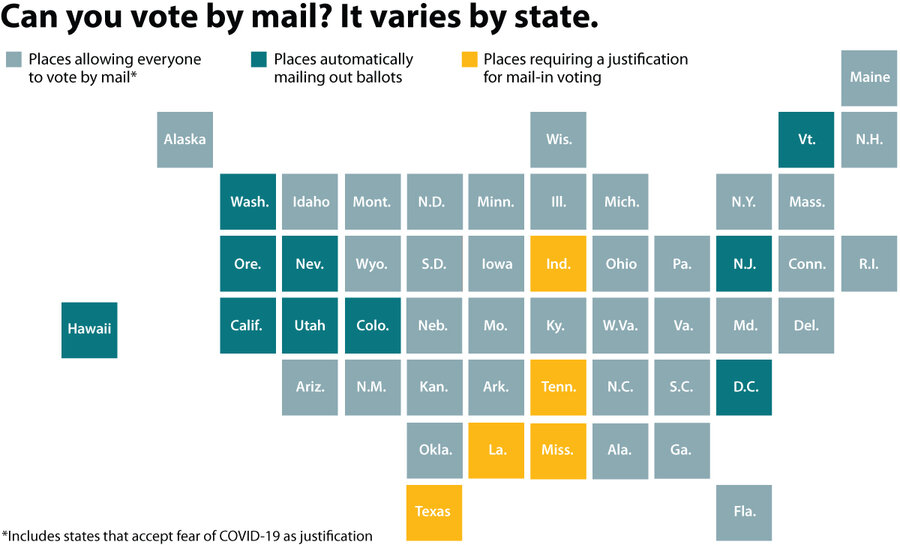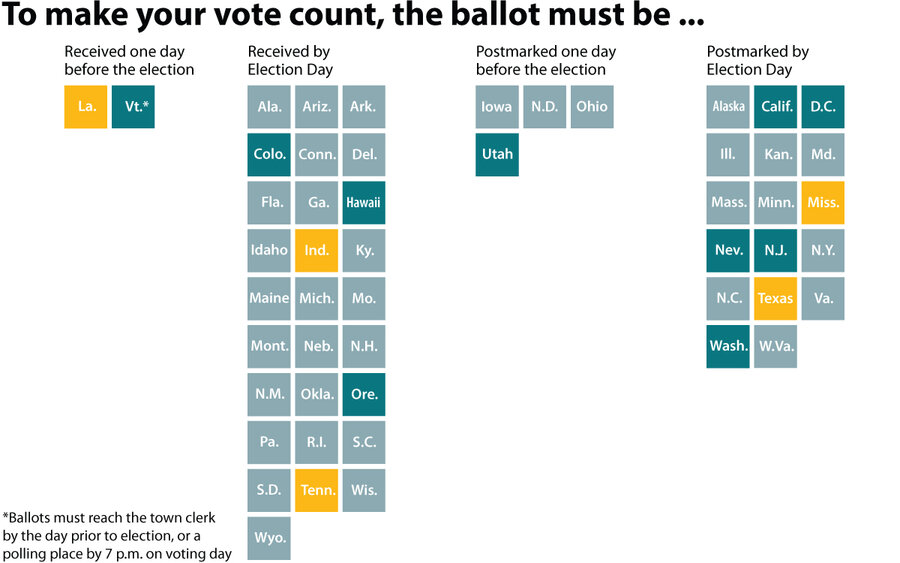Voting by mail: How to make your ballot count
Loading...
With the pandemic, mail-in voting appears set to reach record levels this year. The risk of fraud has become a topic of contention, yet experts say the biggest problems have to do with human error rather than malfeasance. So it pays to learn the rules.
Requirements vary by state and sometimes even at the local level. Most voters will be allowed to vote by mail this fall if they wish, but generally an application is needed. Nine states and the District of Columbia are sending mail-in ballots to all registered voters.
Why We Wrote This
Voting by mail was on the rise even before the pandemic. But as the practice surges in 2020, is America ready? One antidote to election chaos is individual action – knowing the rules and deadlines.
Voting experts recommend being early – both in applying for ballots and sending them in. Doing so, they say, will help ease the burden on the postal system, allow voters flexibility to correct potential mistakes, and make the Nov. 3 vote count closer to the eventual total.
“The vast majority of Americans are not going to have problems,” says Myrna Perez, director of voting rights and elections at the Brennan Center for Justice. “What we don’t want is for people to be hearing about all the problems and all the glitches and feel like their vote doesn’t matter.”
Dropping your vote in the mail may sound convenient, but what if you’ve never done this before and the stakes in the election seem, well, pretty high?
All across the United States, including in hotly contested states from Arizona to Florida, many Americans are in precisely that position.
Nov. 3 may be Election Day, but in response to the coronavirus pandemic the process of voting is already underway. Physical voting stations will still play a major role in 2020. But, in an election year marked by unusual levels of social and political turmoil, absentee and mail-in voting appear set to reach record levels.
Why We Wrote This
Voting by mail was on the rise even before the pandemic. But as the practice surges in 2020, is America ready? One antidote to election chaos is individual action – knowing the rules and deadlines.
Will this process work? How do people make sure their vote counts?
Although the risk of fraud with mail-in ballots has become a topic of contention, experts say the biggest problems have to do with human error rather than malfeasance. In New York City this summer, some primary races remained undecided for about six weeks after voting day, and an unusually high 1 in 5 mail-in ballots were rejected for being late or improperly filled out.
The lesson: Especially for citizens using those methods for the first time, careful planning is essential.
The Monitor spoke with multiple election experts for advice on how voters can properly mail their ballots this fall. They say it’s largely a matter of following directions and meeting deadlines. If you want to vote by mail, they recommend following these steps.
1. Know your area
Since each state manages its own elections, the American voting system comes in 50 parts, each with its own quirks. Requirements can also vary at the local level, which means voters need to understand their specific options and rules when making a plan.
Important information is available on city, county, or state election websites. Either there or over the phone, people can check if they are registered to vote and even eligible for mail-in voting.
In all but five states, Americans concerned about COVID-19 will be able to vote by mail.
Most states require constituents to apply for a mailed ballot online, in person, over the phone, or through the mail. Some states are mailing applications to all registered voters. Nine states and the District of Columbia are going even further: They are automatically sending mail-in ballots to all eligible voters.
2. Know your deadlines – and be early
In states where mail-in ballots must be requested, voters need to know the deadline for requesting them. In turn, there are deadlines for completed ballots to be sent in. In many states they must be postmarked by Election Day, but in many others they must be received by Election Day. Knowing the difference can be vital.
Two states – Louisiana and Vermont – require that ballots must be received a day before the election.
With vote-by-mail volume expected to be so high this year, experts also recommend that voters apply for and mail their ballots as early as possible, rather than waiting until closer to Election Day. Doing so, they say, will help ease the burden on the postal system, allow voters flexibility to correct potential mistakes, and make the Nov. 3 vote count closer to the eventual total.
Some states let voters track their mailed ballots, and some also alert voters of mistakes on their ballot. To know their vote arrives safely, correctly, and on time, an earlier vote is a better vote.
“Go ahead and literally today – probably yesterday – make sure to get those requests in and turn that [ballot] right back around,” says Andrea Hailey, CEO of Vote.org. “Every year we say have a plan. This year, in the middle of a pandemic, it’s more important than ever to give yourself as much time as possible.”
3. Follow directions
The benefit of mail-in voting lies mostly in its safety and convenience. Its drawback is that a disproportionately high number of mailed ballots are disqualified, usually as a result of human error.
Without in-person election officials and real-time feedback, citizens are more prone to mistakes. And such mistakes are likely to be more common this year, with so many Americans voting from home for the first time. In years past, the number of disqualified ballots has been as large as or larger than a candidate’s margin of victory.
“Being careful about following the rules, about filling out bubbles or making sure you filled out the correct lines, is even more important when voting by mail,” says John Fortier, director of governmental studies at the Bipartisan Policy Center. “There are not the checking mechanisms that you have at the polling place.”
The best way to avoid potential pitfalls is to read and follow all the directions closely, say Mr. Fortier and other experts. A very small number of locales have special technical requirements, like getting the ballot notarized. Others require a signature that matches one on record, most often taken from a driver’s license – and which voters can update or check on their state electoral board online or over the phone.
The electoral ballot will also include information for its return – whether voters can send it by mail, drop it off in person, or leave it in a dropbox. Some states will include pre-authorized postage with the ballot, while others make voters attach it themselves.
4. Have faith
With so much misinformation circulating about the reliability of the U.S. Postal Service and voting by mail, experts warn against cynicism, which could chill turnout. Other misconceptions about voting by mail – that the ballots are only counted in close elections, for example – might have a similar effect, says Mr. Fortier.
“The vast majority of Americans are not going to have problems,” says Myrna Perez, director of voting rights and elections at the Brennan Center for Justice. “What we don’t want is for people to be hearing about all the problems and all the glitches and feel like their vote doesn’t matter.”
Despite the extra steps it may require, she says, voting at home is safe and trustworthy. There will be complications. The pandemic has put enormous strain on America’s election infrastructure. But glitches or disqualified ballots are by far the exception, not the rule, says Ms. Perez.
If citizens still worry about voting by mail, she says, they should remember that in-person polling places will still be open and that other options are available.
And ... consider getting involved
Since many people will still vote in person, volunteering at a polling center can be enormously helpful. As the coronavirus depresses volunteer turnout, younger voters at less risk from COVID-19 can make a major contribution by working the polls, says Ms. Hailey.
While voting is a collective right, she says, it’s also somewhat of a collective responsibility. This election will occur under chaotic circumstances, but if Americans play their part, they can make sure the election itself isn’t chaotic.
“To avoid disenfranchisement and long lines we’re really encouraging a new generation of voters to step up and volunteer to become poll workers to make sure that everyone in their community can have their voice heard,” says Ms. Hailey.
Editor’s note: As a public service, we have removed our paywall for all pandemic-related stories.









